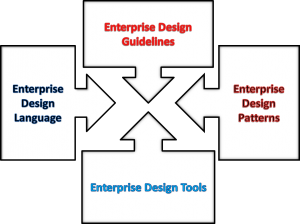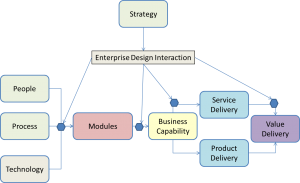Enterprise Driven Design
In any use of the term enterprise as used in business, enterprise refers to things that are organization wide. In domain driven design by Eric Evans, domains bring in the context of a business context or area. Enterprise-driven design recognizes that an organization is not just a collection of domains. What are the unique aspects of design when viewed across domains? That is what we are attempting to answer. Like Eric, we use the word design rather than architecture. This follows the 1972 comparison between how architects and engineers think by Bryan Lawson. In our usage here there is no functional difference between the two except that we consider design an activity and architecture a result. This is just convenience on our part.
EDD as a Framework
A framework is an operational and reusable form of framing a problem or solution space. In building architecture the frame provides the structure until the building structure is strong enough to stand on its own. When this exists in a context of an architecture rather than the structure the framework is the cognitive language and tools the illuminate and enable comparison between different designs. It exists at the meta-level
Based on classes taught at DePaul University CDM Graduate School 2010-2013. The end-product of the class was for each student to produce their own framework for either a real or imagined company. It had to reference one or more current enterprise architecture frameworks including TOGAF, Zachman,, FEAF, and DODAF.
This work is to contain the practices that cut across these frameworks for an individual to create a personalized framework for their firm.
Introduction
To create frameworks there needs to be a canvas that frames the concepts and provides the context for the design. In EDD these are meta-concepts that are seen within enterprise architecture. Each meta-concept represents a concept of practice that is seen while applying design to an enterprise. Rationalization occurs when two meta-concepts are so close together that they cannot be disambiguated from each other. These are mentioned in the descriptions in the meta-concepts. The canvas provides the core. The other part is the elements. These are the paints, brushes, and material that are used to paint on the canvas. The last are the strokes and how they turn into a picture. This is for you the architect.
The Canvas
The canvas is contained within three platforms of meta-concepts.
Strategic Platform provides the positioning for the framework. How does one conceive of ideas and fit them within the enterprise.
Operational Platform operationalizes the framework for how the meta-concepts can be developed into practices.
Execution Platform Adds the relevancy connecting the operational platform to value in the enterprise.
The Material
Enterprise-Driven Design provides the practices, patterns, language, and tools to design enterprises.
Enterprise Design Guidelines are the constraints for designing a good framework.
Enterprise Design Language are the nouns that are designed around.
Enterprise Design Patterns are the verbs that are used to attach the nouns in repeatable forms.
Enterprise Design Tools are the modeling languages, automated tools, etc. that help create the framework.
What are Enterprises?
Thorstein Veblen in 1908 characterized the business enterprise as combining people, processes, and technologies. This required investment since integrating these pieces to fit like one would machine was not automatic. It took time. Alfred D. Chandler in 1990 added to this concept, introducing the administrative enterprise, which had a professional core of managers that administered the enterprise leveraging economies of scale and scope. This differentiated the enterprise view of the firm from the business view of the firm.
The people processes and technologies are wrapped into modules that optimize the opportunities available to the firm. The potentiality of the optionality in the modules is realized through business capabilities that are then exposed as potential new services and products that can be mined for competitive advantage. This view is different than that used in business for supply chains, which is more focused on functions, operations, and deliverables, rather than the potentiality within the enterprise.
Designing Enterprises
To design and enterprise is not an abstract exercise. The purpose is to capture the individual rational of the participants as shared logic. In designing a business the resources of the firm provide the rational and the logic represents the compromises in allocating those resources. The enterprise is driven competitively by its capabilities, which are the future forward look at the firm.

